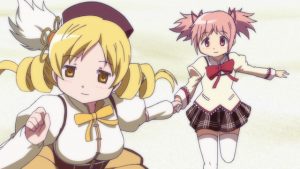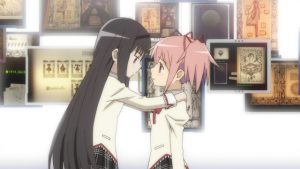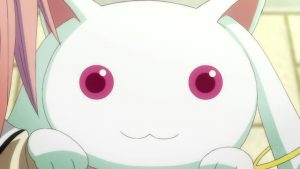
Madoka Magica is a story of contrasts. Sectioning off its world, the show bars the gates to each characters’ past, ending their childhood forever. However, through an understanding of duality, a light emerges. To their backs are walls, but ahead lies the rest of the world.
Continuing from the last article, the purpose of eye imagery will be contextualized further. By sharing Homura’s perspective, we see how her worldview forms and how the show brings about the dawn of a new spring.
Through Her Eyes: A World Without “Magic”
Episode 10 reveals that Madoka Magica is “cyclical.” These characters have gone through similar events before, and Homura is burdened with that knowledge. Now, the audience shares her perception--we are finally allowed to move, feel, and empathize with her. To capitalizes on this, this episode features more “eye shots.”
When Homura accepts Kyubey’s contract, she does so to save Madoka. Her soul gem manifests. She reaches towards the sky and the camera follows Homura’s perspective. As she looks above, her soul gem is at the center of the shot. Surrounded by clouds, her soul gem forms an “eye in the sky.” She clasps her hands over her soul gem as if in prayer.
For a brief moment, Homura is allowed to hope.
If the world were compassionate, then the rain might fall across her cheeks, share in her sorrow over losing someone. However, Homura will learn quickly that children do not survive; they die becoming adults.
As she brings her soul gem closer, the shot zooms into her eye, and we see the sands of time fall. The cogwheels of her shield turn, and it spirals towards the center, enveloping the shot in light. The shot then fades to black, and the “camera’s eye” opens, blinks, then closes. Homura’s face is seen from above. She was asleep before, but now she has awakened.
Fourteen minutes into episode 10, the main cast has killed a witch hatched from Sayaka’s soul gem. In despair, Mami kills Kyouko. Aiming her gun at Homura, she cries, “If soul gems give birth to witches… then we have no choice but to die.”
Before she pulls the trigger, Madoka fires first. The next shot is zoomed out, and we see Mami’s body fall to the floor. In the background are the city lights. From the center is a light so bright it forms a circle around it--eye imagery once more. From this point onwards, Homura can’t afford to be a child--she doesn’t have time to be one.
Homura’s power is time and in any other show, this would be powerful. However, she doesn’t truly control it. The more she uses her power, the more she changes. The world hasn’t changed. The only thing that’s different is Homura’s perception.
When Homura is saved again by Madoka, Madoka begs to be killed. As the rain pours above them, Homura brings out her gun. As she aims it towards Madoka, one thing becomes clear: if magic is hope, then magic does not exist.
Walpurgisnacht and Context
In the real world, Walpurgisnacht is (Walpurgis Night) also called Saint Walpurga’s Eve, an event celebrated on the night of April 30 and ends the morning of May 1. Traditionally, this event was meant to venerate Saint Walpurga who protected Christians from sickness and witchcraft.
In Germany, Walpurgis Night also coincides with Hexenacht (Witch’s Night), which is an event where witches were believed to congregate and revel with the devil on Brocken, the highest peak within the central German mountains. This peak is also the site where Goethe, the German author of the play Faust, has his titular character meet Mephistopheles and share communion with witches.
While regional differences do exist, a similarity does arise. By celebrating the last day of winter, people witness the rebirth of nature. People ward off winter’s evil spirits by dressing up and burning bonfires as they await the dawning of spring’s first light.
A Spring Light to the Winter Night
In Madoka Magica, Walpurgisnacht is the end--an event that marks the destruction of Mitakihara City. By borrowing its real-world counterpart, the show will establish the birth of a saint-like figure. What marks an end can also mark a beginning.
Homura has never seen a future without an end. Holding nothing back, Homura uses artillery, tanks, and weapons of all calibers to attack the final witch, destroying much of the city around her.
As episode 11 reaches its climax, we bear witness to Homura’s defeat. Barely conscious, her eyes struggle to stay open. In the distance, the witch floats around like a spectral iris. The lids of Homura’s vision close, forming a shape around the witch’s body.
In this shot, Homura’s perspective forms an eye around the witch’s body. It stares back at her as if to say that these two are mirrors of one another--that Homura’s future, the very lessons she has embodied, is the very thing she stares upon.
Angered by this, Homura violently reaches for her shield and winds it. However, a thought occurs, “If I go back again… I’ll only make Madoka’s destiny worse. Then in the end…everything I’ve done…” Her arm falls down, punctuating her thoughts.
Everything she has done has been for nothing.
Zooming out, we see the truth we knew all along: Homura can no longer move; her right leg is broken, a cruel reminder that she’s gone nowhere. Despair takes over and her soul gem darkens. But just as it nearly fills, the person who’s saved her before appears once more. Madoka stands before a dying Homura.
A warm light dawns upon the cold world.
Final Thoughts

Homura rejects the very lessons of her genre. Despite her power, she cannot change an inevitable outcome. Time moves forward only to repeat itself. Frozen by her very magic, Homura no longer moves in this cold, uncaring world. In the final article, I will discuss how Madoka Magica gives significance to suffering and reaffirms faith in its genre.




